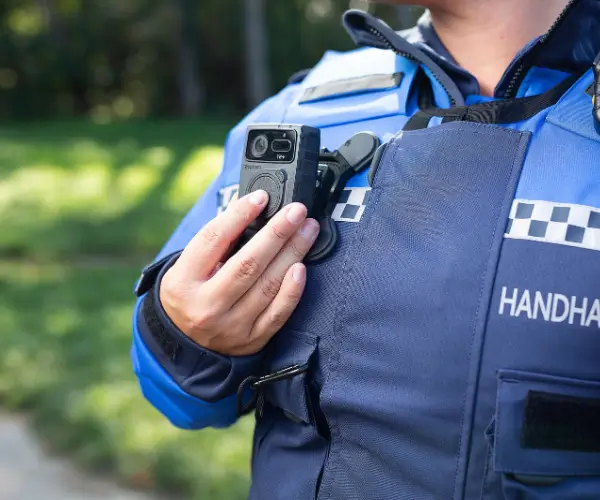Navigating Bodycam Evidence Admissibility in Europe

The use of body-worn cameras (bodycams) by police and law enforcement forces in Europe has significantly improved evidence gathering. Bodycam footage has played a crucial role in convicting offenders in courts, notably increasing transparency and accountability for law enforcement agencies and the judicial system. However, its admissibility in court depends on a complex interplay of legal, procedural, and evidentiary considerations. It’s important to note that laws can vary by country, but the General Data Protection Regulation (GDPR) provides a common foundation across the EU.
Legal Framework
Bodycam evidence in Europe is governed by:
- EU-wide regulations: Chiefly, the General Data Protection Regulation (GDPR)
- National legislation: Specific to each country
- Local procedural rules: Dictating evidence admissibility
Key Admissibility Criteria
- Relevance and Materiality: Footage must be pertinent to the case and offer probative value.
- Authenticity and Integrity: Courts require assurance that footage hasn’t been tampered with through:
- Robust chain-of-custody documentation
- Technological safeguards
- Expert testimony, where necessary
- Privacy and Data Protection: Compliance with GDPR and national laws is crucial for ensuring that bodycam footage is admissible as evidence in court. Key factors include:
- Obtaining Necessary Consent: Lack of proper consent may render the footage inadmissible, especially in private settings.
- Data Minimisation Techniques: Over-collection of data can violate privacy laws, potentially rendering the footage inadmissible.
- Secure Storage and Access: Failure to securely store footage and control access can raise questions about its integrity and authenticity, leading to challenges in court.
- Proportionality: Use of footage must be proportionate and not unduly infringe on individual rights.
- Fair Trial Considerations: Both the prosecution and defence must have equal access to footage.
Technological Advancements and Challenges
- Artificial Intelligence: Offers potential for automated redaction and evidence analysis but raises accuracy and bias concerns.
- Cybersecurity: Digitisation of evidence creates new vulnerabilities, necessitating robust security measures.
- NIS2 Directive: The NIS2 Directive aims to enhance cybersecurity across the EU, providing a framework for securing networks and information systems. This is crucial for the secure storage and handling of bodycam footage.
- Face Recognition: A Contentious Frontier
- Potential: Swift identification of suspects or witnesses in footage
- Challenges:
- Privacy concerns and mass surveillance risks
- Accuracy issues, especially with diverse populations
- Ethical implications of real-time identification
- GDPR Status (as of 2024):
- Not explicitly prohibited, but subject to strict conditions
- Requires EU or Member State law authorisation
- Must be necessary, proportionate, and safeguarded
- Several EU countries are considering or implementing specific regulations.
- Emerging Technologies: 5G, blockchain, and augmented reality present new opportunities and challenges for handling and presenting evidence.
Public Perception
Public opinion increasingly influences bodycam policies and evidence admissibility:
- Growing demand for police transparency
- Debates on the balance between safety and privacy
- Varying attitudes across Europe towards police use of technology
Best Practices for Law Enforcement
- Invest in secure, high-quality bodycam systems and data management infrastructure.
- Develop clear, publicly available policies on bodycam use and data handling.
- Implement comprehensive training programmes for officers.
- Engage with communities about bodycam use and policies.
- Prioritise robust cybersecurity measures.
Maximising the Value and Trust in Bodycam Evidence
The admissibility of bodycam evidence in European courts presents a complex landscape of legal, technological, and social considerations. As technology evolves, law enforcement agencies must navigate the challenges of implementing advanced tools whilst adhering to strict legal standards and addressing public concerns. By embracing best practices, fostering transparency, and remaining adaptable, agencies can maximise the evidentiary value of bodycam footage whilst safeguarding individual rights and maintaining public trust.
As a European specialist in GDPR-compliant bodycam solutions, ZEPCAM is here to assist your organisation in achieving these goals. Reach out to us today to ensure that your bodycam usage is in line with the highest standards of privacy and legal compliance.
Disclaimer
This blog post provides a general overview of GDPR requirements for bodycam usage. Organisations should consult the GDPR legislation and seek legal advice specific to their circumstances. National and local laws may also impose additional requirements. The guidance here is intended to assist in understanding and implementing GDPR principles while respecting individuals’ privacy rights.

